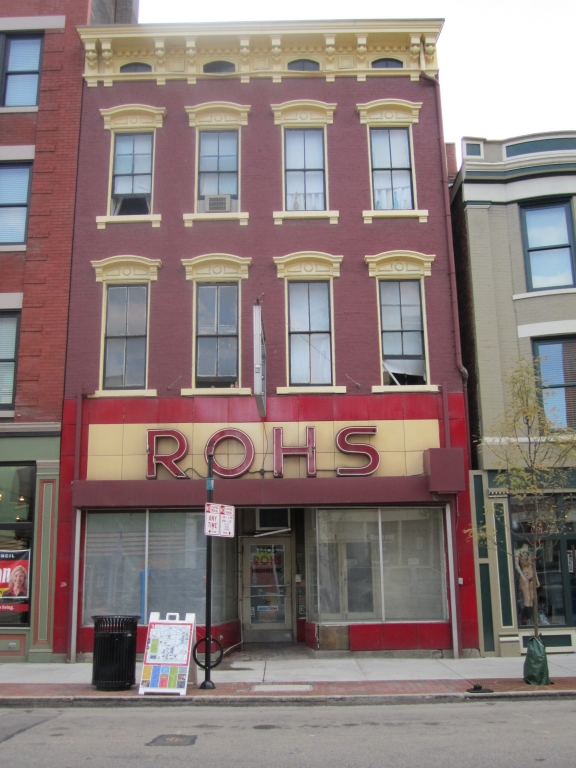In homage to the museum’s host city, we are focusing on a “Signs of Cincinnati” theme for the new home’s events area. Because the majority of those visiting the museum for a reception or other event would probably be local folks, we wanted to feature our collection of local signs in some capacity.
That was really the only nod to our hometown until recently . . .
The Over-the-Rhine area of Cincinnati has been undergoing redevelopment during the last two years, particularly the Vine St. corridor. Among the local businesses on Vine that closed down was Rohs (pronounced “Ross”) Hardware, located in an 1880s storefront typical of Over-the-Rhine. Rohs Hardware opened for business in 1933 under the management of its proprietor, one Albert G. Rohs.
What caught my eye originally were the neon-illuminated, porcelain enamel letters that fronted the building. Circa late 1940s or early 1950s, I guessed. I had approached the current owner – Albert R. Rohs, Albert’s son – about the letters upon seeing “Going out of business” signs in the window back in the late spring.
However, when I walked up to the front door, I realized that the entire storefront had been retrofitted with porcelain enamel panels, stretching from the sidewalk to approximately 12 ft. high, or roughly 3-4 ft. above the storefront windows. I thought to myself, “What a great addition the façade would make to our ‘Signs on Main Street’ exhibit area.”
As it turned out, the business did close, and a local developer, Rick Kimbler of Northpointe Realty (Cincinnati), acquired the building from Rohs. I asked him about the intended fate of the porcelain panels, and he said they were probably going to remove and discard them. I told him of my plans, and he thought it an appropriate re-use. He agreed to talk with his general contractor, Bill Baum of Cincinnati-based Urban Sites.
Advertisement
A few days later, Baum gave me a basic go-ahead, suggesting we meet to coordinate the removal of the porcelain letters and panels. In the meantime, I called Sean Druley, who would be building all of our displays and storefronts, just as he had at the existing museum.
We drove downtown, tape measures in-hand, to see how it might fit into the already designed streetscape. As luck would have it, we saw that we could eliminate one row of vertical panels and fit the slightly diminished storefront into an existing storefront space.
Then a road block presented itself. When I met Baum later that week, he brought along Mark Gunther of Wichman Gunther Architects. “There’s a good deal of Federal money financing the redevelopment,” Gunther said, “and we have to meet historic-preservation criteria. Odds are, removing the panels will jeopardize the federal money.” My heart sank.
Of course, I was conflicted. I’m all for historic preservation, and, quite honestly, I could understand why leaving the panels intact was the right thing to do.
In the meantime, the Cincinnati Enquirer, our local daily, featured the museum’s new home in its Labor Day weekend Sunday edition. The possible reuse of the Rohs storefront was mentioned. That prompted Albert’s daughter, Karen Rohs Laib, to e-mail the reporter about how great it would be if the Rohs storefront went to the museum. I sent copies to all the parties involved.
Three or four weeks went by, and then I got call from Bill Baum. “Hey, they’re all yours,” he said anticlimactically. “Let me know if you need my crew’s help in getting them down.” I immediately called Sean and told him the great news.
Advertisement
Baum had requested the porcelain be removed as soon as possible, so we opted for Tuesday at 1 p.m., leaving the following day to finish the job.
It rained all Monday and into the next day, but, just around noon, it cleared up. We enlisted the help of a friend, Toby Costello, and set to work by 1 p.m. By 5 p.m. that day, we had all the panels and letters down and strapped onto my trailer – far ahead of schedule. Wednesday, our original completion day, it rained from dawn to dusk.



 Tip Sheet1 week ago
Tip Sheet1 week ago
 Photo Gallery3 days ago
Photo Gallery3 days ago
 Ask Signs of the Times5 days ago
Ask Signs of the Times5 days ago
 Real Deal2 weeks ago
Real Deal2 weeks ago
 Benchmarks1 week ago
Benchmarks1 week ago
 Photo Gallery3 hours ago
Photo Gallery3 hours ago
 Women in Signs2 weeks ago
Women in Signs2 weeks ago
 Women in Signs1 week ago
Women in Signs1 week ago









